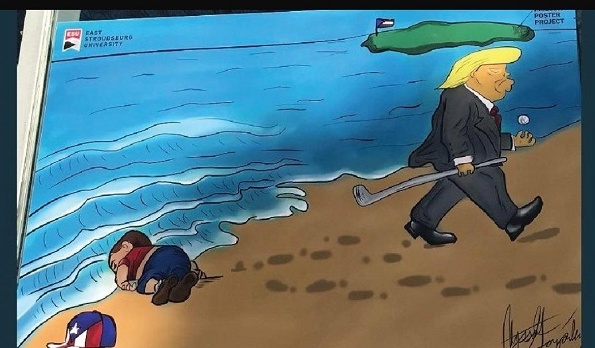
By Laura Null
Staff Writer
Conversations have been sparked on campus surrounding the controversial Inclusion Poster Project last week.
The 30 posters were hung throughout the campus displaying various projects on political, racial, ethnic, cultural, gender differences, barriers and multiple other topics and issues people face every day.
Design Professor David Mazure for Graphic Design 1: ART 220 led the project. His classes partnered with Philosophy Professor T Storm Heter and his Human Rights and Freedom: PHIL 235 students. The project was funded by Provost Jo Bruno.
Last Monday night, the university held a public forum in Beers Lecture Hall for students and staff to discuss the posters and for Mazure, Heter and Bruno to answer any questions.
Out of the 30 posters, two seemed to be the most talked about around campus and in the open forum.
The one poster featured Martin Luther King, Jr. standing in front of a crowd on the top-half of the poster, with the quote “Do you stand up for your rights…” The second bottom-half of the same poster showed former NFL player Colin Kaepernick kneeling with the quote “…or take a knee?”
This poster was vandalized and torn down. It has since been replaced and rehung by the university.
The second poster, created by junior art and design major Alyssa Gonzales from Allentown, Pa., received the most feedback out of all of the posters.
It was hung above Stroud Hall’s main entrance, with a depiction of Donald J. Trump holding a golf club walking in the opposite direction of a young boy dead by the beach, with his head in the water.
A hat with the Puerto Rican flag on it sits beside him, and in the background, there is a tiny island with the Puerto Rican flag.
Originally, the artworks were displayed around campus with no caption or description of the artist’s message. Heter said that this was to allow for people to get their own interpretation from it.
Then, about three to four days later, captions were put up beside the posters, along with the artist’s intention.
Bruno put out a public statement about the Inclusion Poster Project, stating that the project was inspired by internationally renowned graphic designer Mirko Ilic’s memorable poster exhibition.
“It intends to communicate the unique perspective of ESU students on the topic of inclusion,” she said.
Professor Heter described that the purpose of this project was “to give students a platform to express their own views on inclusion.”
He wanted the students to use their art to show what inclusion meant for them.
Mazure chose unexpected places on campus to hang the posters in order to spark conversations about the importance of inclusion everywhere
The posters received both positive and negative feedback coming from students, staff and facility.
Tweets were sent directly to ESU’s Twitter page saying that the university should not take a stance on political or controversial topics.
Many said that the university’s logo should not have been placed in the corner of every poster.
In a tweet last week, the President of ESU’s College Republicans Matthew Deegan said “@PresidentWelsh is this the political position the University is taking? ESU logo top left corner.” Deegan was referring to the Trump poster in Stroud Hall.
President Marcia Welsh responded in another tweet saying, “Logo only means it is an #ESU student project. A lot of conversation about many of the posters, this one included. Not an #ESU position.”
The university replied with an email sent out Friday stating, “While the posters are marked with the ESU logo, they are not a representation of the University’s position, but rather our commitment to students’ freedom of expression in the context of an intellectual and educational dialogue.”
While some professors and students disagreed with the logo on the posters, others supported it.
At the forum, some students expressed joy that the campus put their logo on the artworks to show that the students are being heard.
Others explained that the project should have been executed or represented another way.
English Professor Allan Benn explained that he was not speaking against inclusion or for censorship, but the project of Trump was too graphic with the boy laying dead in the sand.
Benn described this photo as a “model of one of the saddest photos taken.” Additionally, the boy’s photo is shown as a comparison of the iconic real-life photo taken titled “The Syrian Boy”, referring back to the Syrian refugee crisis.
Some audience members were upset about the Trump artwork because they had interpreted it as Trump beating the boy and killing him.
When students were opposing the artwork from the project, student Eli Downie brought up the recent on-campus protests held by religious groups.
“Who are we as a campus? If we won’t let our students express their views, but let racial protestors, who are we as a campus?” Downie said.
After some students explained that the image of Trump made them uncomfortable, the artist of the Trump painting revealed herself and spoke out saying, “…life’s uncomfortable.”
“It’s meant to invoke conversation,” said student Elijah Brown. “You can disagree, but it allows the conversation to be built up.”
Additionally, while the biggest controversy was the Trump poster and the university’s logos on the posters, some students towards the end mentioned the multiple other inclusion projects on campus.
Amanda Hajzeri described the women warrior project as being empowering.
Other posters included an African warrior and an Asian warrior, topics of depression, gender equality, stereotypes, the multiple combinations of families, dyslexia etc.
“Enjoy the art because art is fundamentally about the discussion,” Heter said
To view these posters visit http://quantum.esu.edu/insider/poster-project-spreads-message-of-inclusion/
Email Laura at:
lnull@live.esu.edu

